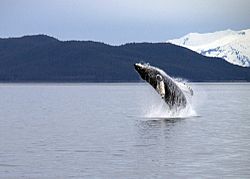Berners Bay facts for kids
Quick facts for kids
Berners Bay
Dax̱anáak / Wóoshde X̱’al.át Yé
|
|
|---|---|
|
Bay
|
|

A whale in Berners Bay
|
|
| Country | United States |
| State | Alaska |
| Time zone | UTC-9 (Alaska (AKST)) |
| • Summer (DST) | UTC-8 (AKDT) |
Berners Bay is a large bay in Alaska, a state in the United States. It is located about 40 miles north of Juneau. The local Lingít names for the bay are Dax̱anáak or Wóoshde X̱’al.át Yé.
The bay is quite wide, about 3.5 miles at its entrance. It stretches about 6 miles inland. The entire bay area is surrounded by the huge Tongass National Forest.
Contents
History of Berners Bay
How Berners Bay Got Its Name
Berners Bay, along with two nearby points (Point Bridget and Point St. Marys), was named by a famous explorer named George Vancouver. He explored and mapped the Alaskan coastline in the 1790s. He named these places after his mother, Bridget Berners, and her hometown, St. Mary's Wiggenhall.
Traditional Life of the Auke People
For a long time, Berners Bay was home to the Wooshkeetaan Auke people. They were a group of Native Alaskans. The Auke people used the bay to gather berries like blueberries, huckleberries, and nagoonberries. They also had smokehouses and a village near the bay. Another village, Kutegan, was further up the Lace River. The Auke people fished in the bay all year round. Today, the area is no longer inhabited by them.
Protecting the Bay
The Clinton administration, which was the US government from 1993 to 2001, officially recognized Berners Bay as an "Aquatic Resource of National Importance." This means it's a very important water area for the country.
Geography and Geology
Rivers and Coves
Berners Bay is an estuary, which is where a river meets the sea. It gets its water from four rivers that come from glaciers. These include the Antler River, the Berners River, and the Lace River. Another stream called Cowee Creek also flows into the bay. The bay stretches about 12 miles north into the land. There's a special protected area inside the bay called Echo Cove.
Gold in the Area
The Berners Bay area is part of a region in Southeast Alaska known for its gold. This area is called the Juneau gold belt. There's a gold mine above the bay called the Kensington mine. However, plans to use this mine have faced many protests. Gold in this area is found in quartz veins within the surrounding rocks.
Plants and Animals
Berry Picking and Plant Life
Berners Bay is famous for its wild berries. You can find blueberries, cranberries, huckleberries, and nagoonberries here. It's the biggest berry-picking spot for people living in Juneau. Other plants like salmonberries, devil's club, and currants also grow here.
Near the mouths of the Antler and Lace rivers, there are large meadows. These meadows are full of grass-like plants called sedges. These "Lyngbye's sedge meadows" are a favorite place for brown bears.

Amazing Wildlife
Every spring, millions of small fish called hooligan and herring swim into Berners Bay to lay their eggs. There can be 10 to 20 million of these fish in the bay!
Steller sea lions love to eat these hooligans. After they've had their fill, the sea lions leave the bay to go to the outer coast. There, they breed and have their pups. Steller sea lions are a threatened species, meaning their numbers are getting low.
Berners Bay is also a breeding ground for different kinds of Alaskan salmon. You can also spot seals and huge humpback whales in the bay.
Further up the rivers that flow into the bay, you might see other animals. These include mountain goats, mink, lynx, moose, wolverine, and both brown and black bears.
The bay is known for having one of the largest groups of bald eagles in Southeast Alaska. It's the second-biggest gathering of eagles in the whole region! Many other shorebirds and seabirds also visit the bay. These include mallards, pintails, green-winged teal, and gulls.
After the hooligan fish lay their eggs and die, their bodies float near the river banks. This provides food for other birds like crows, ravens, and songbirds.
Fun Activities at Berners Bay
Berners Bay is a great place for outdoor activities.
- Kayaking: Paddling a kayak from the calm Echo Cove to the Berners Bay Cabin is a popular trip, covering over 8 miles.
- Fishing: Many people enjoy fishing in the bay.
- Wildlife Watching: It's a fantastic spot to watch birds and whales.
- Air Boating: Some people like to explore the bay by air boat.
- Camping: There are also places to camp and enjoy nature.


